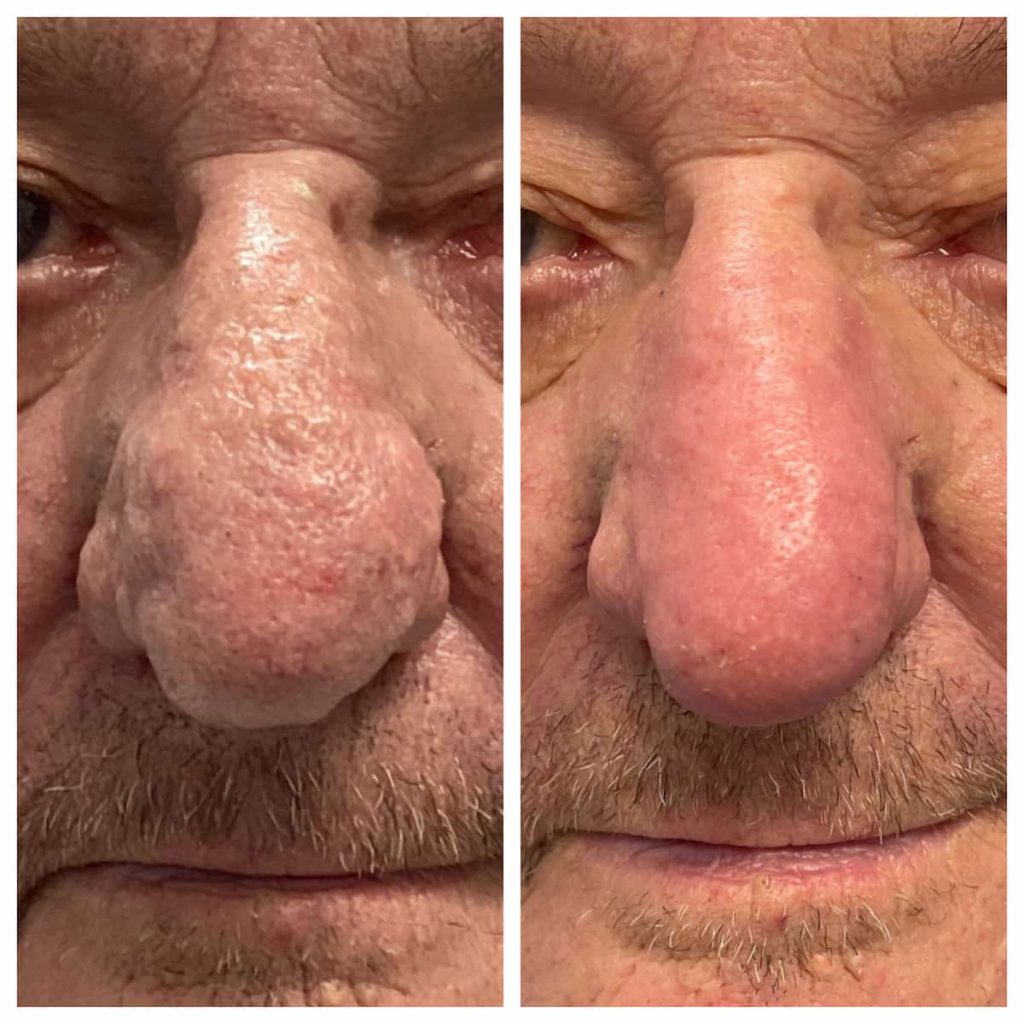Rhinophyma
Explore rhinophyma causes, symptoms, and treatments. This rare skin condition affecting the nose requires professional care.

What is Rhinophyma?
Rhinophyma is characterized by a progressive thickening of the skin on the nose, leading to a bulbous, bumpy appearance. It’s considered the most severe form of rosacea, a chronic inflammatory skin condition. While rhinophyma can affect anyone, it is most commonly seen in fair-skinned older men.
Causes and Risk Factors
The exact cause of rhinophyma is not fully understood, but several factors are believed to contribute to its development:
- Rosacea: Rhinophyma is most commonly associated with rosacea, a chronic skin condition characterized by facial redness, flushing, and visible blood vessels. Not all individuals with rosacea will develop rhinophyma, but those with severe or untreated rosacea are at higher risk.
- Genetics: There may be a genetic predisposition to developing rhinophyma. Individuals with a rosacea or rhinophyma family history are more likely to develop the condition.
- Gender and Age: Rhinophyma is significantly more common in men than women, with most cases occurring in men over 50. The reasons for this gender disparity are not entirely clear.
- Environmental Factors: Certain environmental and lifestyle factors, such as exposure to extreme temperatures, alcohol consumption, and spicy foods, can trigger rosacea flare-ups and may contribute to the development of rhinophyma.
- Sebaceous Gland Hyperplasia: The enlargement of the sebaceous glands in the skin of the nose plays a key role in the development of rhinophyma, leading to the characteristic thickening and bulbous appearance.
It’s important to note that while rhinophyma was once thought to be caused by excessive alcohol consumption, this is a myth. However, alcohol can exacerbate the condition in those who already have it.
Symptoms and Progression
Rhinophyma typically develops slowly over several years. The main symptoms include:
- Nasal Enlargement: The most prominent feature of rhinophyma is the gradual enlargement of the nose, which may become bulbous and misshapen.
- Thickened Skin: The skin on the nose becomes thickened and may feel firm or rubbery to the touch.
- Irregular Surface Texture: The nose’s surface may develop bumps, nodules, or a rough, uneven texture.
- Redness: The nose often appears red or flushed due to increased blood flow and visible blood vessels (telangiectasia).
- Enlarged Pores: The pores on the nose may become enlarged and more prominent, sometimes forming black or whiteheads.
- Difficulty Breathing: In severe cases, the nose enlargement can obstruct the nasal passages, leading to difficulty breathing through the nose.
As the condition progresses, it can lead to significant nose disfigurement, which can cause both functional and aesthetic concerns.
Diagnosis
A dermatologist typically diagnoses rhinophyma through visual examination. At St. Louis Dermatology & Cosmetics, our experienced physicians can accurately diagnose rhinophyma and distinguish it from other skin conditions that may affect the nose.
Treatment Options
While rhinophyma cannot be cured, there are several treatment options available to manage the condition and improve the appearance of the nose:
- Medications: While medications alone are not typically effective for treating rhinophyma, they may be used to manage underlying rosacea symptoms and prevent flare-ups. These may include oral or topical antibiotics, retinoids, or anti-inflammatory medications.
- Laser Therapy: Laser treatments, such as CO2 laser or pulsed dye laser, can remove excess tissue, reduce redness, and improve the texture of the skin. This is often effective in treating mild to moderate rhinophyma.
- Surgical Excision: For more severe cases of rhinophyma, surgical removal of excess tissue may be necessary. This can be done using various techniques, including scalpel excision, electrosurgery (using electrical currents to remove tissue), or cryosurgery (using extreme cold to destroy tissue). Surgery aims to reshape the nose and restore a more normal appearance.
- Dermabrasion: Dermabrasion is a procedure that involves mechanically sanding down the thickened skin of the nose to smooth out the surface and reduce its size. This treatment is often used in combination with other surgical methods.
- Radiofrequency Ablation: This technique uses radiofrequency energy to heat and destroy excess tissue. It is less invasive than traditional surgery and can effectively reshape the nose.
- Electrosurgery: This method involves using an electric current to remove excess tissue and reshape the nose. Electrosurgery can be particularly effective for treating nodules and irregularities on the nose.
- Post-Treatment Care: Proper skin care after treatment is essential to prevent infection and promote healing. Patients are often advised to avoid sun exposure, use gentle skincare products, and follow any specific instructions their healthcare provider provides.
At St. Louis Dermatology & Cosmetics, our approach is tailored to each patient’s specific needs and the severity of their condition.
Living with Rhinophyma
Living with rhinophyma can be challenging due to the cosmetic changes it causes. The condition can affect a person’s self-esteem and lead to social anxiety or depression. Individuals with rhinophyma need to seek support from healthcare providers, who can offer treatment options and resources for coping with the emotional impact of the condition. In some cases, counseling or support groups may be beneficial. There are steps you can take to manage the condition:
- Protect your skin from sun exposure
- Avoid triggers that cause flushing (e.g., hot beverages, spicy foods, alcohol)
- Use gentle skincare products
- Stay consistent with prescribed treatments
When to Seek Professional Help
If you notice persistent redness, swelling, or changes in the shape of your nose, it’s crucial to consult a dermatologist. Early intervention can help prevent the progression of rhinophyma and achieve better treatment outcomes.
At St. Louis Dermatology & Cosmetics, we understand rhinophyma’s physical and emotional impact. Our dermatologists are committed to providing compassionate care and effective treatments to help you manage this condition and regain confidence.
Don’t let rhinophyma control your life. Contact St. Louis Dermatology & Cosmetics today to schedule a consultation. Together, we can develop a personalized treatment plan to address your concerns and improve the health and appearance of your skin.
GET IN TOUCH

